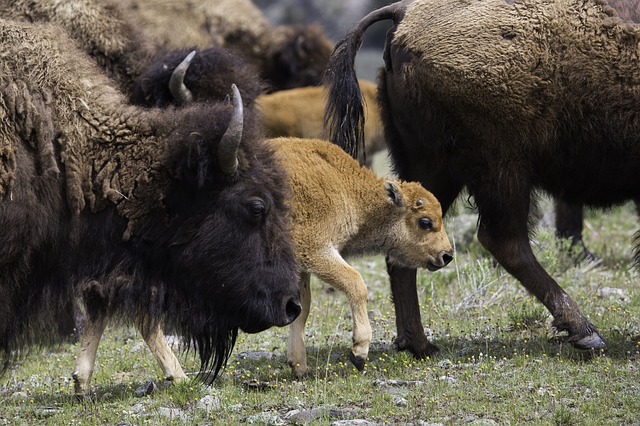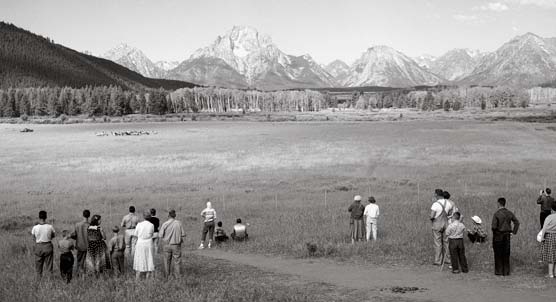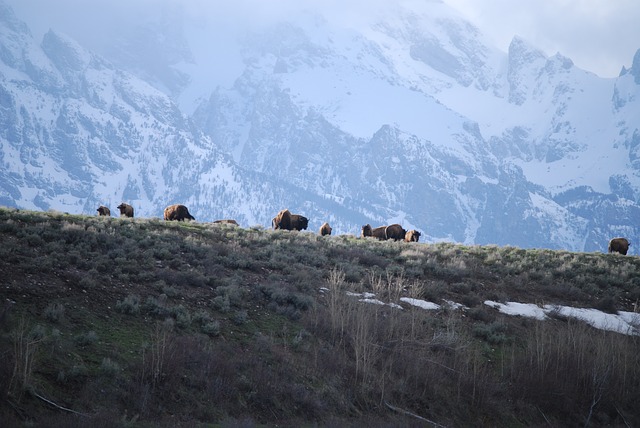
Bison Chronicles
By Ben Wise
With recent media coverage of bison populations in the Greater Yellowstone Ecosystem (i.e. Montana bison reduction program, bison calf abductions in Yellowstone National Park and the recent adoption of bison as the National Mammal), it seemed fitting to review the origin of the bison population in Jackson Hole. Bison are native to Jackson Hole but had been extirpated by as early as 1884 when homesteaders arrived in the Jackson Valley. The last remaining bison population in the western United States occurred in Yellowstone National Park and by 1902 numbered only 23 individuals.
In 1948, Laurance S. Rockefeller’s Jackson Hole Preserve cooperated with the New York Zoological Society and Wyoming Game and Fish Commission to establish a fenced wildlife park near present day Moran. The Jackson Hole Wildlife Park served to attract visitors to the Jackson Hole National Monument (now Grand Teton National Park), as well as serving as a scientific research center and a place where visitors could easily view wildlife. The creation of the Wildlife Park was quite controversial and led to the resignation of renowned Olaus Murie from the board of the Jackson Hole Preserve.

Jackson Hole Wildlife Park photo credit: Grand Teton National Park
Shortly after the Jackson Hole Wildlife Park’s creation, 20 bison were relocated from Yellowstone National Park to fenced enclosures within the park. Management of the Park was primarily the responsibility of the Wyoming Game and Fish Commission until the expansion of Grand Teton National Park in 1950. At that time, management of the Park began shifting to the National Park Service. Throughout the 1960s, management actions were coordinated with the Wyoming Game and Fish Department and included winter-feeding, capturing bison that escaped (which occurred several times annually), and routine brucellosis testing and vaccination. Herd size varied from 15-30 until 1963 when brucellosis was documented in the herd. Thirteen adults were removed from the herd, leaving just four yearlings. The yearlings, which had been vaccinated, were retained, along with five new calves that were also vaccinated.
In 1964, 12 certified brucellosis-free adults (six males and six females) were obtained from Theodore Roosevelt National Park in North Dakota, bringing the total number to 21. By 1968, the population had declined to 11 adults (all testing negative for brucellosis) and four or five calves. Later that year, the entire herd escaped the confines of the Wildlife Park. Efforts to recapture the bison were unsuccessful and the decision was made to let the herd roam free.
From 1969-1976 the population averaged 14 animals. The bison wintered within Grand Teton National Park until 1975, when they moved to the National Elk Refuge. By 1980, bison were taking advantage of the supplemental feed intended for elk. The bison readily adapted to the situation, as they had no trouble displacing elk from the feedlines, and subsequently, the population started to grow rapidly. The population peaked at approximately 1,200 animals before a hunt was established on the Refuge in 2008. Currently, the population is estimated at 666 animals. The objective for the population is 500. Refuge personnel have provided separate feedlines for bison on the northern end of the Refuge near McBride since 1984 to minimize conflicts between bison and elk. Jackson bison winter primarily on the National Elk Refuge and summer almost entirely within the boundary of Grand Teton National Park.

About Ben Wise:
Ben Wise is a member of Nature Mapping Jackson Hole Scientific Advisory Committee and is the Brucellosis-Feedground-Habitat Biologist with the Wyoming Game and Fish Department.
